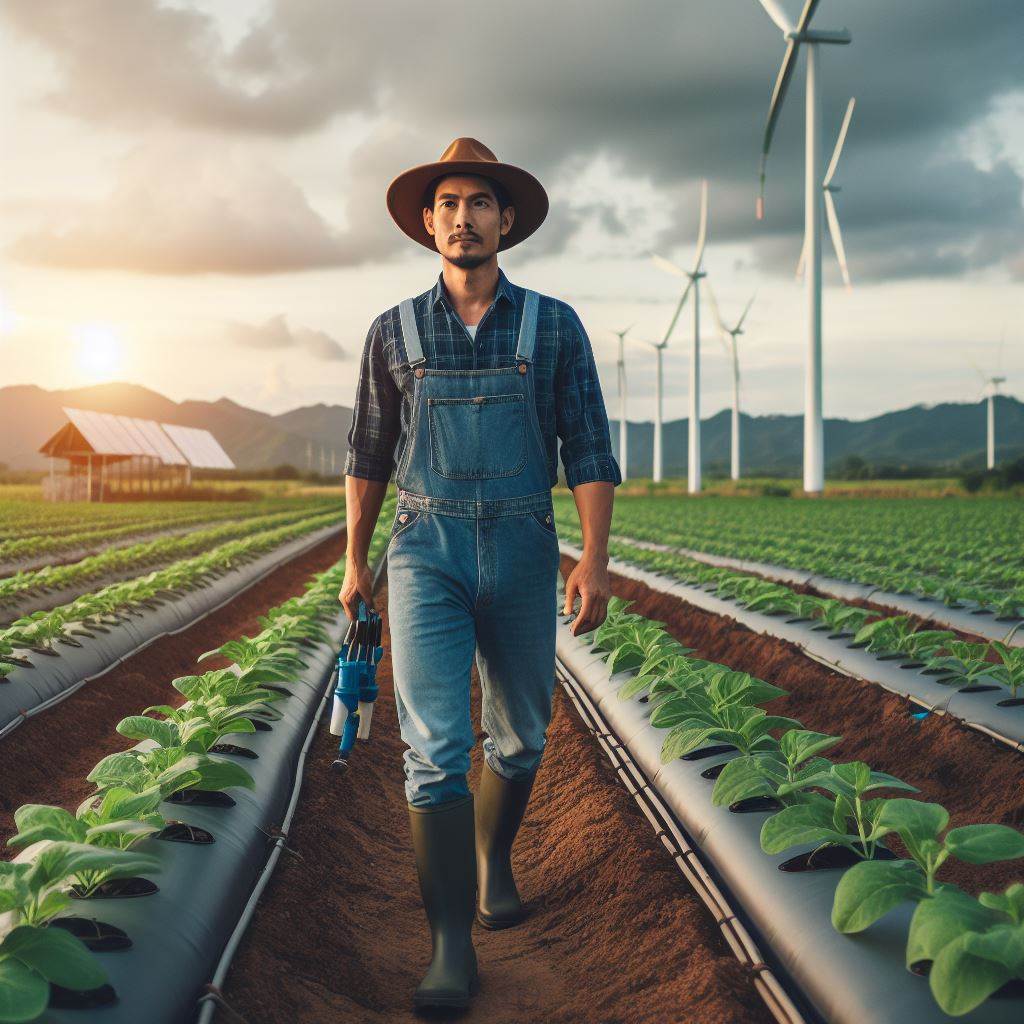Introduction
Importance of pest control in sustainable farming
Pest control plays a vital role in sustainable farming by preventing crop damage and ensuring high yields.
Overview of the post’s content
In this blog post, we will discuss the importance of effective pest control methods and how they contribute to sustainable farming practices.
By implementing these methods, farmers can protect their crops from pests and reduce the need for harmful chemical pesticides. This not only benefits the environment but also improves the quality and safety of agricultural products.
Effective pest control promotes balanced ecosystems, supports biodiversity, and minimizes the risks associated with pest infestations.
Thesis statement on the significance of implementing effective pest control methods in sustainable farming
By using integrated pest management strategies, farmers can maximize their crop production while minimizing the negative impact on the environment.
Basically, implementing efficient pest control methods is crucial for sustainable farming as it ensures the long-term viability of agriculture and protects the planet for future generations.
Understanding Pest Control in Sustainable Farming
Definition of pest control
Pest control refers to the management and regulation of pests, which are organisms that can harm crops or livestock.
Sustainable farming practices
Sustainable farming practices involve techniques that minimize negative impacts on the environment and promote long-term agricultural productivity.
Linking pest control with sustainable agriculture
Benefits of pest control in maintaining crop yield and quality
Pest control measures help protect crops from damage caused by insects, weeds, and diseases.
By eliminating or reducing pests, farmers can ensure a higher yield and better quality of their crops.
This leads to increased profitability and food production to meet growing global demand.
Minimizing environmental impacts using sustainable pest control methods
Conventional pest control methods often involve the use of synthetic pesticides, which can harm non-target organisms and pollute soil and water systems.
However, sustainable pest control practices aim to minimize these environmental impacts.
One approach is integrated pest management (IPM), which uses a combination of techniques to control pests.
This includes using biological controls, such as beneficial insects, crop rotation, and employing resistant crop varieties.
Transform Your Agribusiness
Unlock your farm's potential with expert advice tailored to your needs. Get actionable steps that drive real results.
Get StartedAnother method is cultural control, which involves altering farming practices to reduce pest populations, such as optimizing irrigation and fertilization.
By adopting these sustainable pest control methods, farmers can achieve effective pest management while minimizing harm to the environment.
To summarize, pest control plays an essential role in sustainable farming practices. By effectively managing pests, farmers can maintain a high crop yield and ensure better food quality.
Moreover, using sustainable pest control methods minimizes negative environmental impacts, promoting long-term agricultural productivity and preserving the ecosystem.
Read: Diverse Crops for Healthier Soil
Common Pest Control Methods in Sustainable Farming
Crop rotation and diversification
Crop rotation involves planting different crops in succession to disrupt pest life cycles and prevent build-up. Diversification refers to growing a variety of crops to confuse pests and minimize damage.
Crop rotation and diversification play a significant role in sustainable pest control. By alternating crops in a specific area, pests that rely on a particular crop become disrupted and face difficulties in survival.
Additionally, diversification creates a more complex farming system, making it harder for pests to locate and attack their preferred plants. Both practices effectively reduce the risk of pest outbreaks and decrease reliance on chemical pesticides.
Companion planting
Companion planting promotes the growth of beneficial plants alongside susceptible crops to repel pests or attract natural enemies.
Companion planting is another technique used in sustainable farming. By intercropping beneficial plants alongside susceptible crops, farmers can deter pests naturally.
For example, planting marigolds with tomatoes repels nematodes, while planting mint near cabbages repels harmful insects.
Furthermore, certain companion plants attract beneficial insects, such as ladybugs or lacewings, which act as natural predators, keeping pest populations in check.
Biological control
Biological control involves using natural predators, parasites, or pathogens to control pest populations and maintain ecological balance.
Biological control involves using nature’s own weapons to combat pests. Introducing natural enemies like predatory insects or parasitoids can effectively reduce pest populations.
Ladybugs, for instance, feed on aphids, while parasitic wasps attack pests by laying eggs inside them. Biological control methods are environmentally friendly and can restore ecological balance, minimizing the need for synthetic pesticides.
Organic pesticides and natural alternatives
Organic pesticides and natural alternatives are essential components of sustainable pest control. Botanical extracts and oils derived from plants like neem, garlic, or pyrethrum have insecticidal properties.
These organic pesticides are less persistent and have minimal impacts on non-target organisms. Similarly, pheromone traps and repellents that mimic pest attractant signals can effectively lure and trap pests or deter them from crops.
- Utilization of botanical extracts and oils: Natural substances derived from plants can be used as organic pesticides.
- Implementation of pheromone traps and repellents: Pheromones attract pests to traps or repel them by replicating natural chemical signals.
Integrated Pest Management (IPM) approach
Integrated Pest Management (IPM) is a comprehensive approach that combines various pest control methods. By incorporating multiple techniques, farmers can enhance pest control while minimizing the use of chemical pesticides.
The components of IPM include regular pest monitoring, setting economic thresholds for intervention, implementing preventive measures, and using targeted treatments based on pest life cycles.
Monitoring pest populations and knowing their thresholds enable farmers to intervene at the appropriate time, effectively reducing pesticide use.
- Components of IPM: IPM combines various pest control methods to minimize the use of chemical pesticides and prioritize sustainability.
- Importance of monitoring pest populations and thresholds: Regular monitoring helps determine when intervention is necessary, avoiding unnecessary pesticide applications.
Implementing pest control methods in sustainable farming practices is crucial for maintaining crop health and avoiding environmental harm.
Continuously relying on conventional chemical pesticides can have detrimental effects on ecosystems, pollinators, and human health.
Therefore, sustainable farmers adopt alternative pest control strategies that minimize the use of harmful chemicals and promote natural pest management techniques.
In summary, sustainable farming practices prioritize the use of natural pest control methods to protect crops and the environment.
Showcase Your Farming Business
Publish your professional farming services profile on our blog for a one-time fee of $200 and reach a dedicated audience of farmers and agribusiness owners.
Publish Your ProfileCrop rotation, diversification, companion planting, biological control, organic pesticides, and IPM are valuable tools for sustainable pest management.
By implementing these practices, farmers can achieve effective pest control while minimizing negative impacts on ecosystems and human health.
Embracing sustainable pest control methods is not only environmentally responsible but also essential for the long-term viability of agriculture.
Read: Best Conservation Farming Tips

Challenges and Considerations in Pest Control for Sustainable Farming
Achieving successful pest control while promoting biodiversity is a delicate balance that sustainable farmers strive for. It requires careful consideration of various factors and challenges.
Balancing pest control and biodiversity
- Sustainable farming practices aim to protect and enhance biodiversity in the ecosystem.
- However, indiscriminate use of pesticides can harm beneficial insects, birds, and other wildlife.
- Farmers must find a way to manage pests while minimizing negative impacts on biodiversity.
Potential risks associated with organic pesticides
- Organic pesticides are commonly used in sustainable farming as an alternative to synthetic chemicals.
- However, some organic pesticides can still pose risks to human health and non-target organisms.
- Farmers need to carefully evaluate the potential hazards and effectiveness of organic pesticides.
Implementing long-term strategies for pest prevention
- Sustainable pest control involves more than just immediate eradication of pests.
- It requires a holistic approach to address the underlying causes of pest problems.
- Farmers can adopt practices like crop rotation, companion planting, and habitat manipulation to prevent pest infestations.
Assessing economic feasibility and cost-effectiveness of pest control methods
- Sustainable pest control methods should not only be environmentally friendly but also economically viable.
- Farmers must weigh the costs and benefits of different pest control strategies.
- Factors like labor requirements, initial investments, and long-term effectiveness should be considered.
Generally, pest control in sustainable farming presents various challenges and considerations for farmers.
They must find ways to achieve a balance between pest control and biodiversity conservation.
Additionally, they need to carefully assess the risks and benefits of organic pesticides.
Furthermore, implementing long-term strategies and considering economic feasibility is crucial for sustainable pest management.
By addressing these challenges effectively, sustainable farmers can minimize the negative impacts of pests while promoting a healthy and thriving ecosystem.
Read: Integrated Pest Management for Crops
Case Studies and Success Stories
Successful pest control practices in sustainable farming
- One successful pest control practice in sustainable farming is the use of integrated pest management (IPM).
- IPM involves the combination of various methods to control pests, such as biological control, cultural practices, and chemical interventions.
- For example, the Good Bug Mix developed by the University of California is a successful IPM approach that utilizes beneficial insects.
- This mix includes ladybugs, lacewings, and parasitic wasps, which prey on pests and protect crops.
- Another successful practice is crop rotation, where different crops are planted in a sequence to disrupt the life cycle of pests.
- Crop rotation helps reduce the population of pests that are specific to certain crops, resulting in sustainable pest control.
Outcomes and Positive Environmental Impacts
- The implementation of successful pest control practices in sustainable farming has shown several positive outcomes.
- These practices have significantly reduced the dependence on chemical pesticides, minimizing chemical pollution in the environment.
- By utilizing biological control methods, farmers have reduced the need for synthetic chemicals, protecting both the environment and human health.
- The introduction of beneficial insects, like ladybugs and parasitic wasps, has led to a decrease in pest populations and increased crop yields.
- Crop rotation has also shown positive impacts by reducing the need for chemical insecticides and improving soil health.
- The positive outcomes of these practices not only benefit the environment but also contribute to the long-term sustainability of farming systems.
Encouraging the adoption and implementation of similar approaches
- To promote the adoption of successful pest control practices in sustainable farming, knowledge sharing and awareness programs are crucial.
- Farmers should be educated about the benefits and feasibility of implementing these practices in their own farms.
- Government agencies, agricultural extension services, and NGOs can play a vital role in disseminating information and providing resources.
- Providing financial incentives and subsidies can also encourage farmers to adopt these sustainable pest control practices.
- Collaboration and networking among farmers, researchers, and experts can facilitate the sharing of success stories and best practices.
- Continuous research and innovation are essential to develop new and more effective pest control techniques in sustainable farming.
In essence case studies and success stories play a crucial role in highlighting the effectiveness of pest control practices in sustainable farming.
By emphasizing successful approaches, examining positive environmental impacts, and encouraging adoption, we can promote the widespread implementation of sustainable pest control methods.
Read: Soil Testing: Key to Effective Fertilization
Conclusion
Recap of the importance of pest control in sustainable farming
Pest control plays a vital role in sustainable farming as it ensures the protection of crops.
Effective pest control in sustainable farming is crucial for maintaining crop health, yield, and quality while minimizing environmental impacts.
It reduces reliance on harmful chemicals, promotes ecosystem balance, and supports long-term agricultural viability. Integrated pest management strategies ensure sustainable pest control practices, fostering resilient farming systems and food security.
Reinforcement of the benefits and viability of sustainable pest control methods
Sustainable pest control methods not only benefit the environment but also the farmers’ profitability.
Sustainable pest control methods offer numerous benefits, including reduced environmental impact, preservation of beneficial insects, and minimized chemical exposure.
They promote ecosystem balance, ensure long-term agricultural viability, and contribute to healthier soils and crops. Embracing these methods supports sustainable farming practices and fosters a more resilient food system.
Final thoughts on the significance of continued research and innovation in pest control for sustainable agriculture
Continued research and innovation in pest control are necessary for the long-term success of sustainable agriculture.




